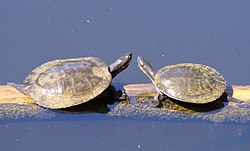Emydura macquarii
Species of turtle From Wikipedia, the free encyclopedia
Emydura macquarii, also known as the Murray River turtle, Macquarie River turtle, eastern short-necked turtle, eastern short-neck turtle, and southern river turtle, is a species of freshwater turtle in the family Chelidae. Named after the Macquarie River of New South Wales, the turtle is a wide-ranging species that occurs throughout many of the rivers of the eastern half of Australia.
| Emydura macquarii Temporal range: | |
|---|---|
 | |
| Macquarie turtle Emydura macquarii | |
| Scientific classification | |
| Domain: | Eukaryota |
| Kingdom: | Animalia |
| Phylum: | Chordata |
| Class: | Reptilia |
| Order: | Testudines |
| Suborder: | Pleurodira |
| Family: | Chelidae |
| Genus: | Emydura |
| Species: | E. macquarii |
| Binomial name | |
| Emydura macquarii | |
| Subspecies | |
| Synonyms[5][6] | |
|
E. m. macquarii (Gray 1830)
E. m. emmotti Cann, McCord & Joseph-Ouni in Mc-Cord, Cann & Joseph-Ouni 2003
E. m. krefftii (Gray 1871)
E. m. nigra McCord, Cann & Joseph-Ouni 2003
| |
Etymology and taxonomy
The generic name, Emydura, is derived from the Greek emys (freshwater turtle) and the Greek oura (tail), Latinized to ura. Its grammatical gender is feminine. The specific epithet, macquarii, refers to the turtle's type locality: the Macquarie River. It would seem that the species was not named after Governor Lachlan Macquarie, for whom the river is named.[8][9]
The species' common names include Murray River turtle,[10] Macquarie River turtle,[11] eastern short-necked turtle, eastern short-neck turtle, and southern river turtle.[12]
The subspecific name, emmotti, is in honour of Australian farmer and naturalist Angus Emmott (born 1962).[9]
The subspecific name, krefftii, is in honour of German-born Australian naturalist Gerard Krefft.[9]
A species formerly thought to be a separate species, the Bellinger River Emydura is now considered synonymous with the Macquarie River turtle.[7]
Collection history and discovery
This species, Emydura macquarii, has a long and complicated nomenclatural history, including even its original description. The holotype was originally collected by René Primevère Lesson (1794–1849) and Prosper Garnot (1794–1838) in 1824. During an expedition on the La Coquille, captained by Louis Isidore Duperrey, which visited Sydney, Australia, from 17 January to 25 March 1824, they visited Bathurst, and collected the holotype from the Macquarie River.[8]
The first description of the species, as Emys macquaria, was offered by Baron Georges Cuvier in 1829,[13]: 11 but this description is nowadays seen as a nomen nudum. Hence, the description, as Chelys (Hydraspis) macquarii, by John Edward Gray in 1830, is considered the valid description.[1]: 15
Geographic range
Emydura macquarii is found across several states:
- in the coastal Queensland rivers and the Cooper Creek ecosystem, along with Fraser Island and Brisbane[10]
- in the Macquarie River basin and all its major tributaries, along with a number of coastal rivers up the New South Wales coast[10]
- in northern Victoria[10]
- in South Australia, in the billabongs and channels of Cooper Creek, and also along the Murray River; also, introduced populations in the Adelaide city area[11]
Description and habitat


The Macquarie River turtle is almost entirely aquatic. Its intergular plate reaches the front edge of the shell, while its plastrons are "cut away", allowing their legs to move freely and thus swim powerfully.[11]
Feeding
The Macquarie River turtle is omnivorous. Its diet includes small crustaceans, aquatic insects, filamentous algae, and possibly aquatic weeds.[7]
Life cycle and sex determination
The Macquarie River turtle nests from October to early January, and multiple clutches of eggs may be laid, in nests excavated in the riverbanks.[7]
Emydura macquarii uses the XY sex-determination system, making it one of the few turtle species that has a genetic sex-determination mechanism. The X and Y chromosomes are macrochromosomes, unlike most genetically sex-determined turtles including its close relative Chelodina longicollis, which has microchromosomes. It is also hypothesised that this turtle's sex chromosomes were formed from the translocation of an ancestral Y microchromosome onto an autosome. It can often be difficult to determine the gender of a turtle when it is young, but it becomes more apparent when it grows.[14]
Importance
Turtles are an important element of the river ecosystem owing to their feeding on dead fish after a fish kill event, returning ammonia and dissolved oxygen to the river much faster than by natural decomposition (3–6 days vs 25–27 days).[15]
Conservation status and efforts
Summarize
Perspective
Threats to the turtles' habitat include water pollution and increased sediment loads from nearby agriculture and forestry activities, construction of bridges and fords, extraction of river sand and gravel, clearing and degradation of riparian vegetation, water diversion, and changes to river flows. Foxes (an introduced species in Australia) and goannas may eat the eggs,[7] and foxes may eat the turtles as well. In South Australia, river system regulation and roadkill are also considered threats to the species.[15]
Efforts to protect the species include the use of professional shooters to kill foxes; working with local councils to build nesting islands, and improving monitoring of species.[15]
Emydura macquarii is listed as "vulnerable" in the state of South Australia under relevant state legislation.[16] After it was found that freshwater turtle numbers had declined by up to 91 per cent some sections of the Murray, conservation efforts increased, with the Government of South Australia allocating $450,000 to help establish the state's first turtle management plan, dubbed the "Together Understanding and Restoring Turtles in our Landscapes and Ecosystems" (TURTLE) project. A management strategy is being developed in collaboration with First Nations people, for whom the turtles have great cultural significance, along with environmental experts.[15]
Parasites
Emydura macquarii is often infected with the flatworm Choanocotyle elegans.[17]
References
Further reading
Wikiwand - on
Seamless Wikipedia browsing. On steroids.

